Tillandsia pruinosa
Click thumbnails for full size, scaled to a new window.
Tillandsia pruinosa
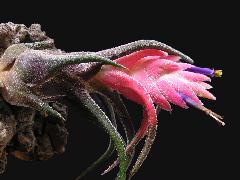
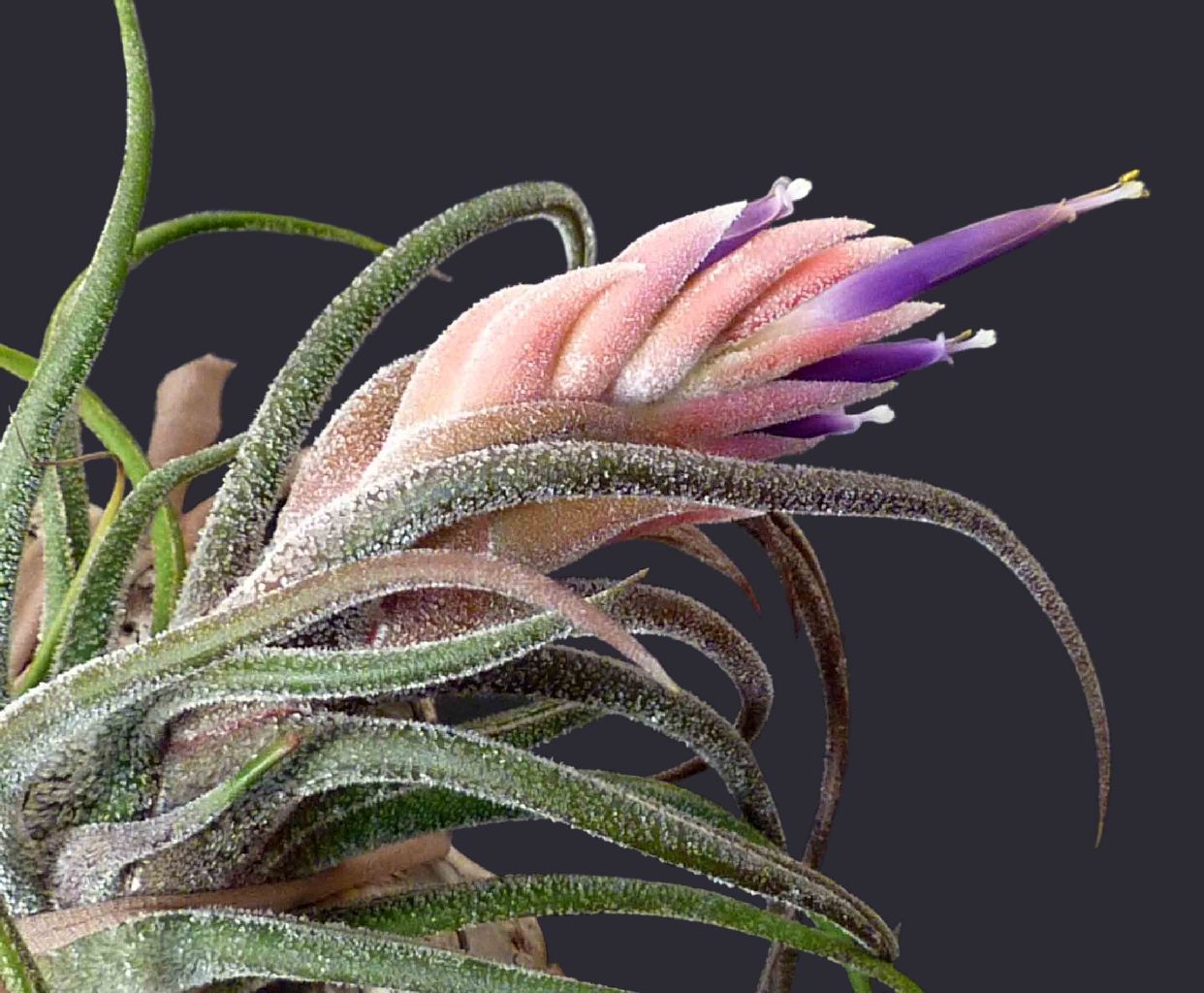


| Ken Woods 05/07 |
Julie Batty 04/17 |
Peter Tristram. Colombian form, Cauca Valley |
Chris Larson 06/17, Colombian form |
Chris Larson ... "Without my files here I cant say if your colour is exactly per description, but pruinosa has a fair sort of range. I have had a range of sizes from Gautemala but all have been the same colour. Very much consistent with both Ross' & Julie's excellent photos.
Variations of colour description and other aspects are always expected. Especially when the distribution is wide."
Len Colgan ... "You might be interested to know that we collected T. pruinosa growing in the wild way down in southern Ecuador, not far from Zaruma. I admit I was absolutely shocked.
However, it is described as having: DISTRIBUTION. Epiphytic, from near sea level to 1200 m alt, Florida, southern Mexico, and Cuba to Ecuador and Brazil.
and does list as the only habitat in Ecuador: ECUADOR. ORO: Zaruma, 1923, Hitchcock 21259 (GH, NY, US).
I assume we bungled into that actual isolated habitat. Isn't it amazing that a species we usually imagine coming from Mexico, Central America and the West Indies can also be found in such a remote distant location? Not to overlook Brazil."
Ross Little ... "Len: Attached is a photo of T. pruinosa I photographed in Ecuador (2015) in that southern area where you mentioned, we only saw the one plant though and we may have been a bit further south. Greg A. will remember the barbed wire fence here when trying to get better photos."
Len Colgan ... "Yes, my location was definitely south of Zamura. It makes one wonder how the DNA of this species from southern Ecuador location matches the DNA from Florida habitats."
Peter Tristram ... "In my experience the pink bracted pruinosa, from commercial nurseries in the US and plants I collected in Costa Rica, usually self-pollinate and set a swag of viable seed, whereas a larger Colombian form (see pic) doesn’t auto-self and has uncoloured bracts. In 2014 Chris, Michael and I saw some on the west side of the Cauca Valley. I wonder if the Ecuadorean form has coloured bracts? Interesting species! The DNA sure could be interesting Len."
Chris Larson 06/17 ... "I have some recollection of a claim that the Colombian form of T. pruinosa does not self. As shown here it does. This is a further comment to my talk in Brisbane. You often get people saying “so & so says this plant doesn’t self. This one does, so it must be the other form”."
Tillandsia pruinosa 'Califano', hybrid?, cultivar worth registering?, or just another form?
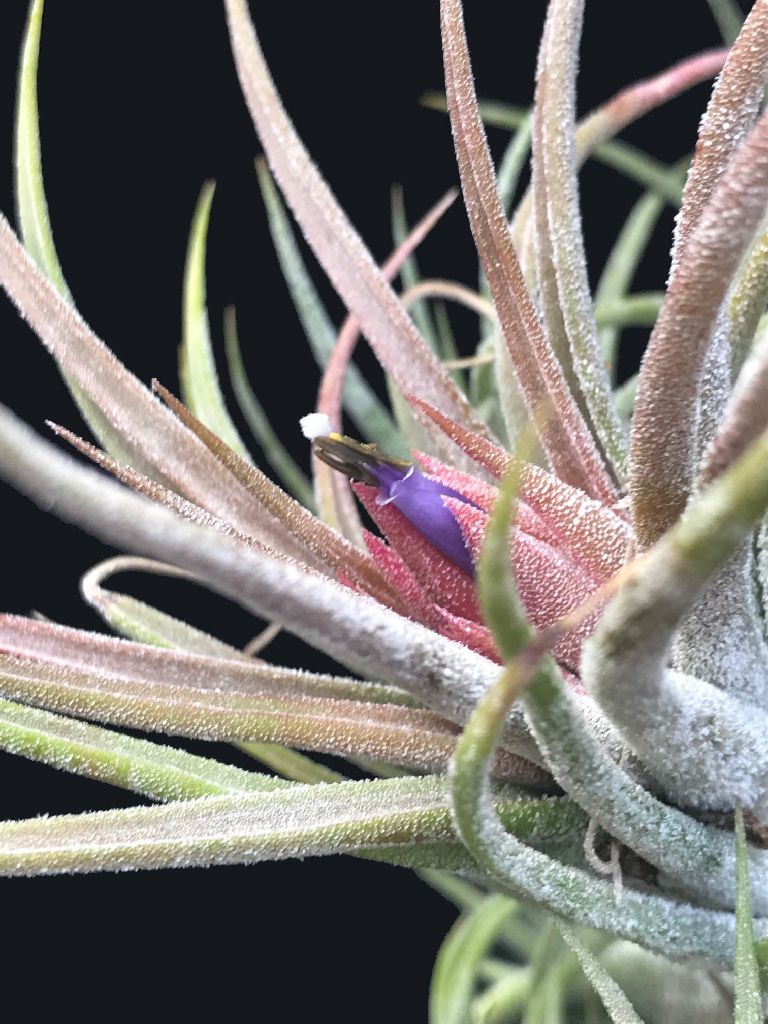
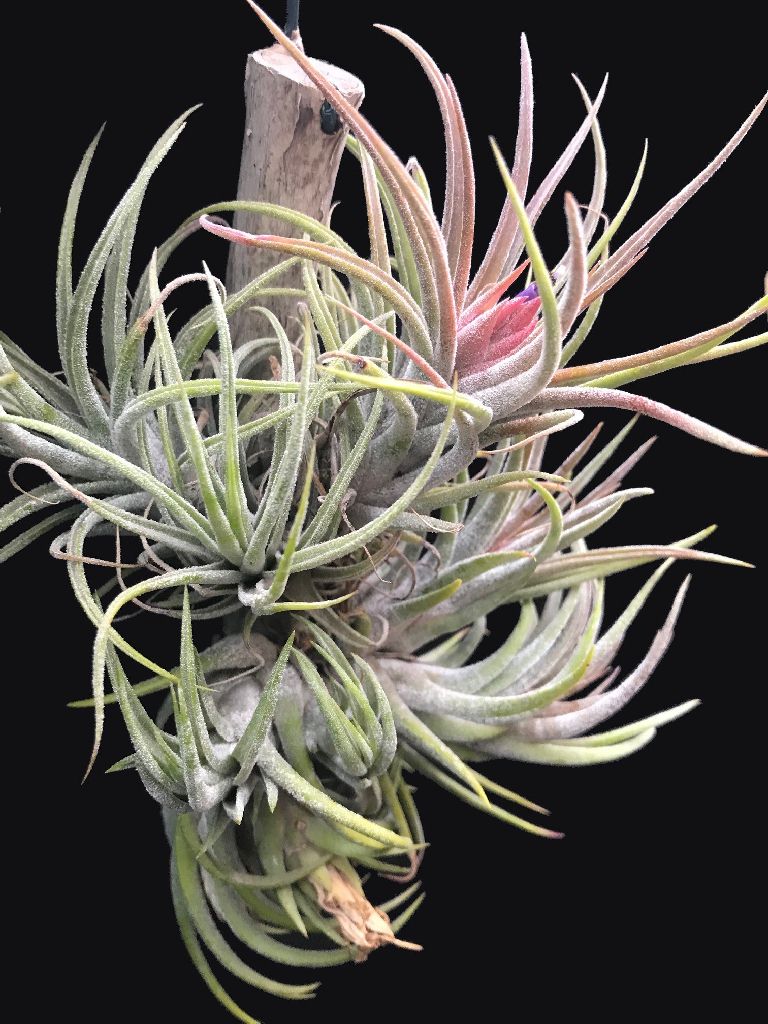
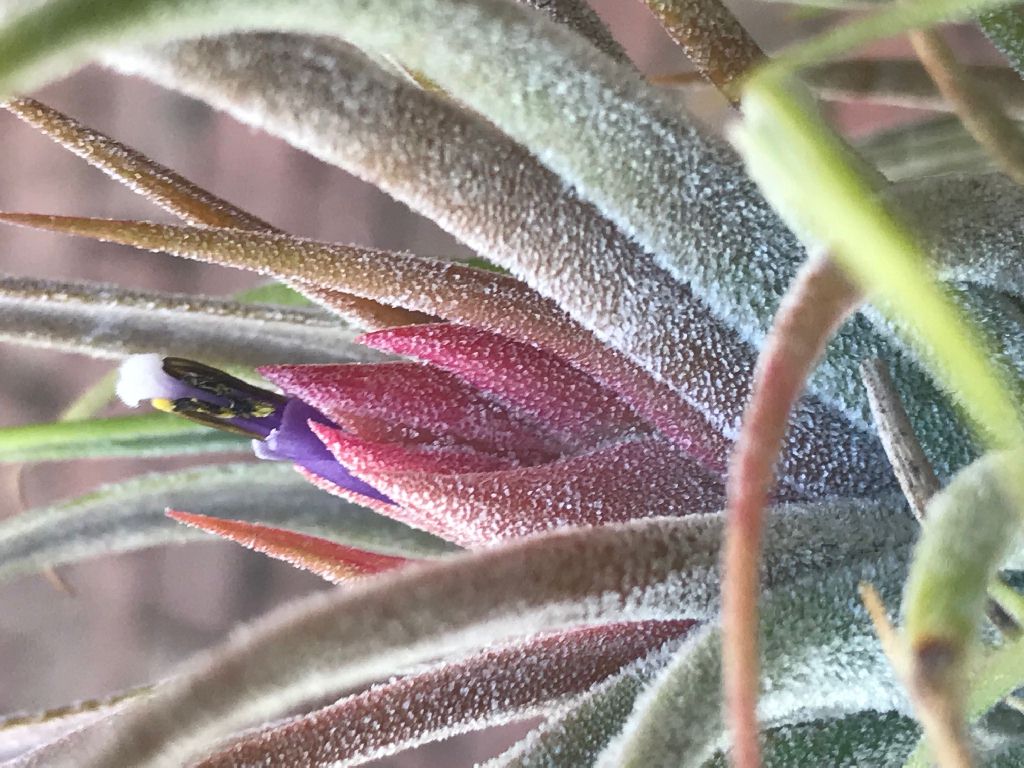
| Geoff Beech 10/19 T. pruinosa 'Califano' |

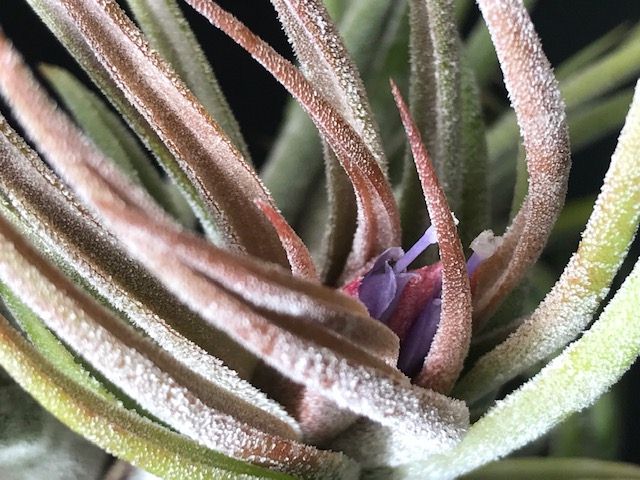
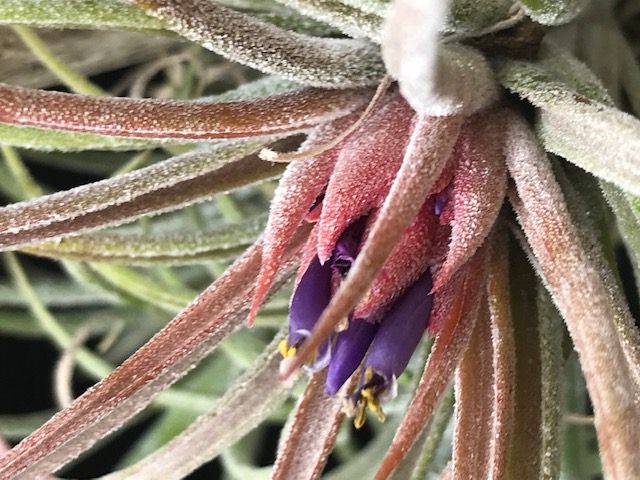
| Geoff Beech 10/19 T. pruinosa 'Califano' Ex. Justin Lee. |
Chris Larson ... "History: It goes back a long way in collections in Melbourne – at least 20 years, but probably more like 30. Can’t say where it originated.
In Brisbane, at the Tillandsia Day in March 2019, someone handed me a huge clump for ID. So it is in Brisbane as well, traveling around without ID.
In selling Len’s plants this year, we sold quite a lot of these. Len Summers Tag says “T.PRUINOSA CALIFANI”.
Geoff Beech has taken the first 3 photos & forwarded them to me.
It has been around long enough that someone else should know it. Do I leave it as a pruinosa? Or should it get a cv name?
If I give it a cv name I will name it after Len Summers. T.Len’s Pruinosa or ……………… any ideas?"
Brenton Cadd ... "Maurice Kellet was selling this plant back when I first started collecting Tills, it was one of the first plants that I purchased from Maurice back in about 1980 give or take a year and I would be quite certain that is where Len Summers got it from also. So if you are going to give it a cv name I think it should have something to do with Maurice because he was certainly growing it long before Len came on the scene. Just my thoughts."
Derek Butcher ... "Continuing with your suggestion I wonder why Califani. We know that Califano was an Italian Tillandsia grower in the 1960's and the plant could have originated there. A sort of ex Califano with the ex missing! This seems a better solution than a new cultivar name. Even ex Kellett could be used."
Chris Larson ... "I have a memory of Califano on the label from the deep past. Is that what you have on yours Brent? Tags can change over time esp as your vision deteriorates with age.
Derek: Are Geoffs photos close enough to T. pruinosa or a hybrid as Peter Tristram seems to think. This is what I am trying to get at."
Derek Butcher ... "Nothing seems to spring to mind regarding differences to the description (see below). If It were my plant I would be taking it to bits. The plant seems to have offset over the years with never a seed raised so we need not worry about an unknown father. When Dale (our resident taxonomist) eventually gets a plant and flowers it we could get his opinion."
Brenton Cadd ... "Yes I think it was Califano. My plant is not alive any longer but from what I remember of it, it did not look close enough to be a straight pruinosa, more likely a hybrid in my opinion."
Geoff Beech ... "A couple more photos of the same plant I got from Justin a few years ago." (Ed. 2nd row above)
Tillandsia pruinosa Swartz, Fl. Ind. Occ. 1: 594.1797.
Tillandsia breviscapa A. Richard in Sagra, Hist. Cuba 11: 265. 1850. Type. Without exact locality, Cuba, Sagra s n (P, GH photo).
Platystachys pruinosa Beer, Bromel. 265. 1857; nomen.
Tillandsia tortilis Klotzsch ex Beer, Bromel. 266. 1857; nomen.
Platystachys tortilis Beer, Bromel. 266. 1857; nomen.
Desc from S&D p984-5
Plant stemless, 8-20 cm high.
Leaves in an elongate pseudobulb, to 2 dm long, densely cinereous-lepidote or ferruginous-lepidote with coarse spreading scales;
Sheaths elliptic to suborbicular, 2-4 cm long, strongly inflated, abruptly contracted into the blade at apex and the inner ones closely enfolding the base of the inflorescence, castaneous;
Blades usually exceeding the inflorescence, linear, involute-subulate, filiform-attenuate, recurved or contorted, 2-4 mm in diameter.
Scape wholly covered by leaf-sheaths.
Inflorescence simple or rarely digitately compound from 2-5 spikes;
Primary bracts ovate, densely lepidote, shorter than the spikes but their foliaceous blades sometimes exceeding them;
Spikes densely and distichously 5-15-flowered, to 7 cm long and 4 cm wide but usually much smaller, acute, complanate, rhachis straight, angled, densely lepidote.
Floral bracts erect, four to five times as long as the internodes, ovate, acute, 20-26 mm long, much exceeding the sepals, carinate toward apex, subcoriaceous, pink at anthesis, densely lepidote with coarse spreading scales;
Flowers sessile.
Sepals broadly elliptic, obtuse, 13-19 mm long, sparsely lepidote or glabrous, coriaceous, subfree;
Petals linear, obtuse or acute, 3 cm long, violet;
Stamens exserted.
Capsule cylindric, acute, to 55 mm long.
Type. Swartz s n (S), without exact locality, Jamaica.
DISTRIBUTION. Epiphytic, from near sea level to 1200 m alt, Florida, southern Mexico, and Cuba to Ecuador and Brazil.
UNITED STATES. FLORIDA, Collier: Everglades, 7 Feb 1948, Woodbury s n (US); 29 Dec 1953, L. B. Smith 7233 (US). MEXICO.
ALISCO: Chamela, 10 Dec 1970, McVaugh 25214 (MICH). VERA CRUZ: Vera Cruz. Ghiesbreght s n (P); Zacuapan, May 1919, Purpus 8229 (GH, MO, NY, US); 1929, Skwarra s n (GH); Mirador, Feb 1927, Reiche 435 (M); 24 May 1929, Skwarra 18 (GH). OAXACA, Pochutla: Concordia, 2 Mar 1937, Makrinius 542 (US). CHIAPAS, Ocosingo: Laguna Ocotal Grande, 1954, DressIer 1468 (US). GUATEMALA. PETEN: La Libertad, Apr 1933, Lundell 2626 (MICH); 2911 (MICH); Monte Santa Teresa, 14 Apr 1933, Lundell 2900 (GH); Tikal, 13 Feb 1959, Lundell 15538 (LL, US); 10 Aug 1960, Contreras 1407 (LL). BRITISH HONDURAS. El Cayo: Valentin, 1936, Lundell 6272 (MICH). HONDURAS. CORTES: Lake Yojoa, 29
un 1934, Yuncker 4839 (F, MICH, MO). COMAYAGUA: Siguatepeque, Feb 1928, Standley 56374 (F). ATLANTIDA: Tela, Lancetilla Valley, 1927-28, Standley 54619 (F); 56584 (F). NICARAGUA. JINOTEGA: Jinotega to La Cantera, 25
un 1947, Standley 10138 (F). COSTA RICA. GUANACASTE: El Arenal, Jan 1926, Standley & Valerio 45325 (US). LIMON: Cairo, Rio Reventazon, Feb 1926, Standley & Valerio 48998 (US); Los Rio Santa Clara, Guapiles, 12 Ju11949, Holm & litis 402 (US). CARTAGO: Las Concavas, Cartago, Dec 1925, Standley 41425 (US); 23 Apr 1956, Williams 19302 (EAP, US); Pejivalle, Feb 1926, Standley & Valerio 47294 (US). CUBA. ISLA DE PINOS: San Juan, Mar 1916, Britton & Wilson 15479 (F, NY, US). PINAR DEL RIO: Buenaventura to San Juan de Guacamalla, 16 Dec 1910, Wilson 9341 (NY); Sierra de Anafe,18 Dec 1911, Wilson 11403 (NY); Sierra de Cabra, 6 Mar 1911, Britton & Cowell 9820 (NY); San Gabriel to Santa Monica, 19 Jan 1912, Shafer11886 (NY); Los Palacios to San Pablo de las Yeguas, 26
an 1912, Shafer 11914 (NY); Sierra Caliente, Sumidero, Aug 1912, Shafer 13776 (NY). LAS VILLAS: Cieneguita, 7 Dec 1895, Combs 671 (GH, MO); Guanabana, Cerro Trinidad, 1910, Britton, Earle & Wilson 4768 (F, NY); Guajimica, 23 Mar 1910, Britton, Earle & Wilson 5831 (NY); Santa Clara, Mar 1910, Britton & Wilson 6146 (Ny); Pico Tuerto, Rio Yayabo, Dec 1911, Clement 2882 (NY); Rincon to Banao, 3 Mar 1912, Shafer 12322 (NY); 2 Aug 1918,Le6n & Roca 8077 (NY); San BIas, La Sierra, 1 Mar 1928,jack 6462 (GH);
un 1941, Howard 5369 (GH); El Purial, 14 Mar 1932,jack 8561 (GH, NY); Mina Carlota, Cumanayagua, Mar 1938, Senn 269 (US). ORIENTE: Holguin to Myabe, 16 Apr 1909, Shafer 1416 (NY); Paso Estancia, 27 Apr 1909, Shafer 1593 (NY); May 1909, 1821 (NY); Arroyo del Medio,
an 1910, Shafer 3328 (NY, US); Monte Verde, 13 Feb 1911, Shafer 8699 (NY); Santiago, May 1937 , Foster III (GH); Sierra Nipe, Oct 1941, Morton & Acuna 3107 (US); without exact locality, 1856-57, Wright 686 (BM, GH, MO, NY, US). JAMAICA. SURREY, St. Andrew: Gordon Town, 15 Feb 1895, Harris Fl Jam. 5527 (NY); 6 Feb 1952, Proctor 6246 (IJ, US). MIDDLESEX, Clarendon: Chapelton, 18 Sep 1906, Underwood 3421 (NY);
an 1916, Ridley s n (K); 21 May 1952, Proctor 6697 (IJ, US). CORNWALL, Trelawny: Troy, Sep 1906, Britton 506 (NY); 4 Apr 1952, Proctor 6529 (IJ, US); St. Elizabeth: Giddy Hall, 16 Feb 1926, Maxwell s n (BM); 9 Mar 1956, Proctor 11692 (IJ, US); Westmoreland: Rat Trap, 23 Oct 1960, Proctor 21470 (IJ, US). REPUBLICA DOMINICANA. SANTIAGO: San Jose de las Matas, 18 Dec 1929, Valeur 294 (F, MO, US); 12 May 1933, Valeur 991 (US); 11 Apr 1930, Ekman H-14604 (S); 13 Oct 1968, Liogier 12997 (NY, US); Rubio, 17 Apr 1946, Jimenez 1092 (US). LA VEGA: Salto de Constanza, Jan 1956, Jimenez 3188 (US). SAN JUAN: Rio Arriba del Norte, San Juan, Sep 1946, Howard 8832 (GH). MONTE CRISTI: Moncion, 16 Jan 1950, Mera in Jimenez 1894 (US); Dajabon, 22 Oct 1969, Liogier 16461 (NY, US). SAMANA: Los Haitises, 24. Jun 1930, Ekman H-15410 (S). COLOMBIA. NORTE DE SANTANDER: Rio Catumbo, Teorama, 11 Sep 1946, Foster 1657 (GH). ANTIOQUIA: Bello, Aug 1944, Emmanuel & Daniel 3313 (COL, GH, MO). TOLIMA: Ibague, Mar 1876, Artore 1751 (K). VENEZUELA. Without exact locality: Fendler 2448 (K). ECUADOR. ORO: Zaruma, 1923, Hitchcock 21259 (GH, NY, US). BRAZIL. PARA: without exact locality, Poeppig s n (L); 1838, Lindley s n (K). ESPIRITO SANTO: Rio Jucu, Vitoria, 14 Jul 1939, Foster 205 (GH, R). RIO DE JANEIRO: Cantagallo, 24 Aug 1884, Glaziou 16461 (P). GUANABARA: Maua, 20 Jul 1895, Glaziou 4052 e p (R); Jul 1897, 4052 e p (CORD).
Detail from Gouda in Flora of the Guianas 1987
17. Tillandsia pruinosa Swartz, Fl. Ind. Occ. 1: 594. 1797.
- Platystachys pruinosa Beer, Bromel. 265. 1857, nom. nud. Type: Jamaica, without locality, Swartz s. n. (S).
- Tillandsia tortilis Klotzsch ex Beer, Bromel. 266. 1857, nom. nud. - Platystachys tortilis Beer, Bromel. 266. 1857, nom. nud.
Plant acaulescent, 8-23 cm tall, with about 10-20 white-tomentose (often ferrugineous when dry) leaves the sheaths forming a small pseudo-bulb.
Leaves 7-25 cm long, exceeding the inflorescence;
sheaths much inflated-convex, abruptly contracted into the blades, chartaceous, suborbicular or elliptic, 2-4.8 x 2-4.3 cm, with broad membranaceous and often purple-red margins, densely subappressed-lepidote to somewhat ferrugineously tomentose-lepidote at the apex, pale-brown, often deep purple inside;
blades suberect, often slightly flexuous or secund, fleshy coriaceous, flexible, involute-subulate, 5-21 cm long, 0.2-0.5 cm in diam., filiform-attenuate, very densely white or somewhat ferrugineously tomentose-lepidote.
Inflorescence simple or rarely digitately compound of 2-4 spikes, 5-15 cm long, densely tomentose-lepidote;
scape erect, 5-8 cm long, 2-3 mm in diam., densely concealed by its bracts and the leaves;
scape bracts foliaceous, suberect, with densely imbricate sheaths, the upper ones more oblong and acutish; axis very short and hidden;
primary bracts as the upper scape bracts, subspreading with the spikes, shorter than or exceeding the spikes by the foliaceous blade;
peduncle suberect or spreading, less than 1 cm long, only prophyllate;
spikes (broadly) elliptic, complanate, 4-6.5 x 1.8-4.5 cm, acutish, densely and distichously 3-6(-15)-flowered, with 1 to a few sterile bracts at the base and apex;
rachis hidden, nearly straight, angled, densely tomentose-lepidote;
floral bracts suberect, imbricate, thin-coriaceous, with even surface, elliptic, 2-2.9 cm long, 4-5 times as long as the internodes, nearly twice as long as the sepals, acutish or obtuse and obscurely apiculate, obscurely carinate at the extreme apex, pale silvery green, tinged with, or wholly dull rose-red.
Flowers tubular-erect, contiguous, sessile; receptacle obconic, bicarinate, ca. 2 mm long;
sepals very thin-coriaceous, with even surface, elliptic, 1.3-1.9 cm long, with broad membranaceous margins, rounded or obtuse, then obscurely acuminate, anteriorly short connate or almost free, posterior ones less than half connate and bluntly carinate at the base, sparsely appressed-lepidote at both sides or subglabrous;
petals ligulate, coiled at the extreme apex, ca. 3 cm long, obtuse or acute, violet;
stamens much exceeding the petals, the shortest 3 about equaling the pistil, the longest exceeding it, filaments flat, but exceeding part dilated, terete and violet, anthers dorsifixed (at 1/3), over 3 mm long;
ovary ovoid(?), contracted into the slender style,
stigmas linear, flattened and twisting.
Capsule cylindric, to ca. 5.5 cm long, attenuately subacute, short-beaked.
Distribution: Florida, S. Mexico, and Cuba to Ecuador and Brazil. Epiphytic, from near sea level to 1400 m alt. 7 collections studied. Surinam, 60 km from Brazil boundary, Paloemeu R., Mt. Kassikassima, Moonen s. n. (U).
Culture and use: A very decorative small species; easily grown like an epiphyte in window or in greenhouse at a bright and sunny, moderately humid location. Propagation by seed, on vertical wire gauze not difficult.
Dale Dixon ... "I’m after images of clumps and individual plants of Tillandsia pruinosa. It doesn’t have to be in flower. If you have this species, could you please send pictures. I’m looking at comparisons with the entity that’s circulating as Len’s Pruinosa or Califani/Califano."
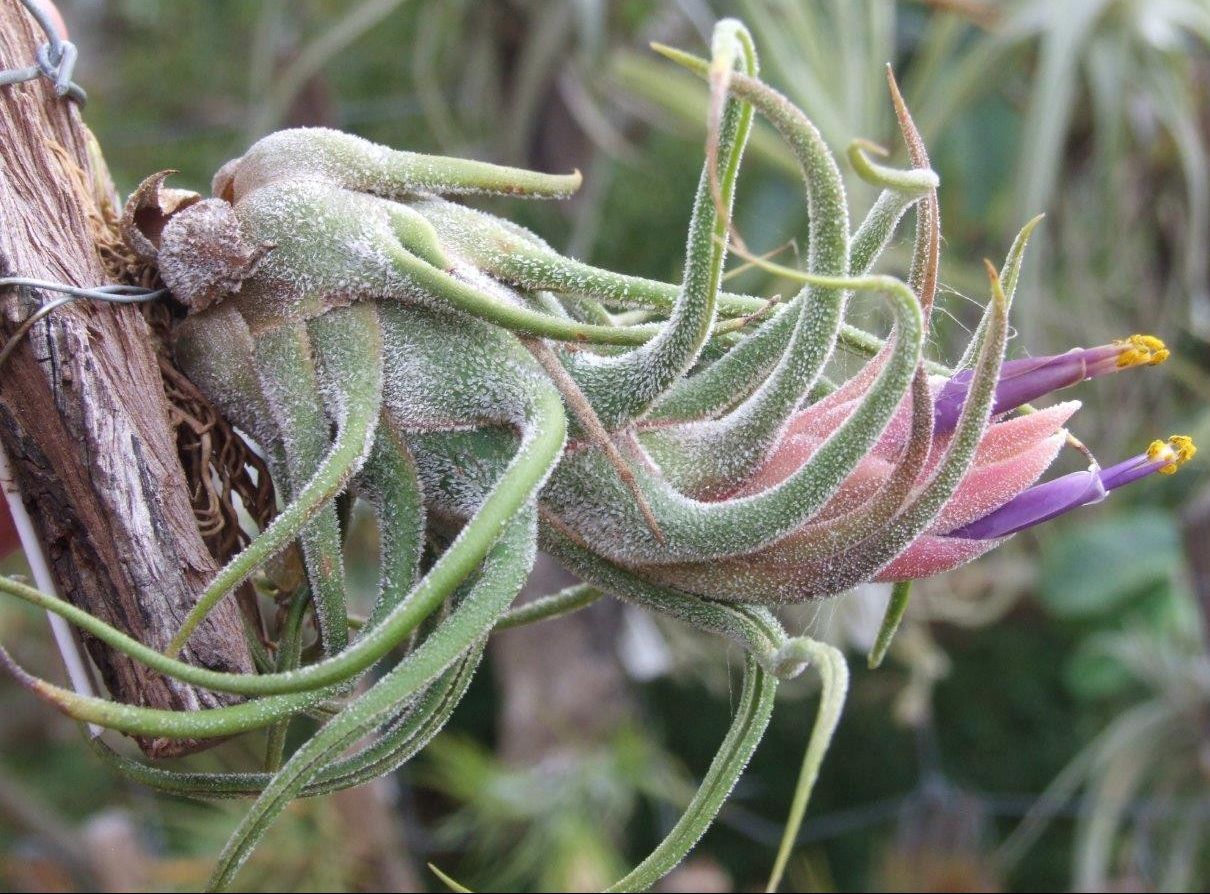
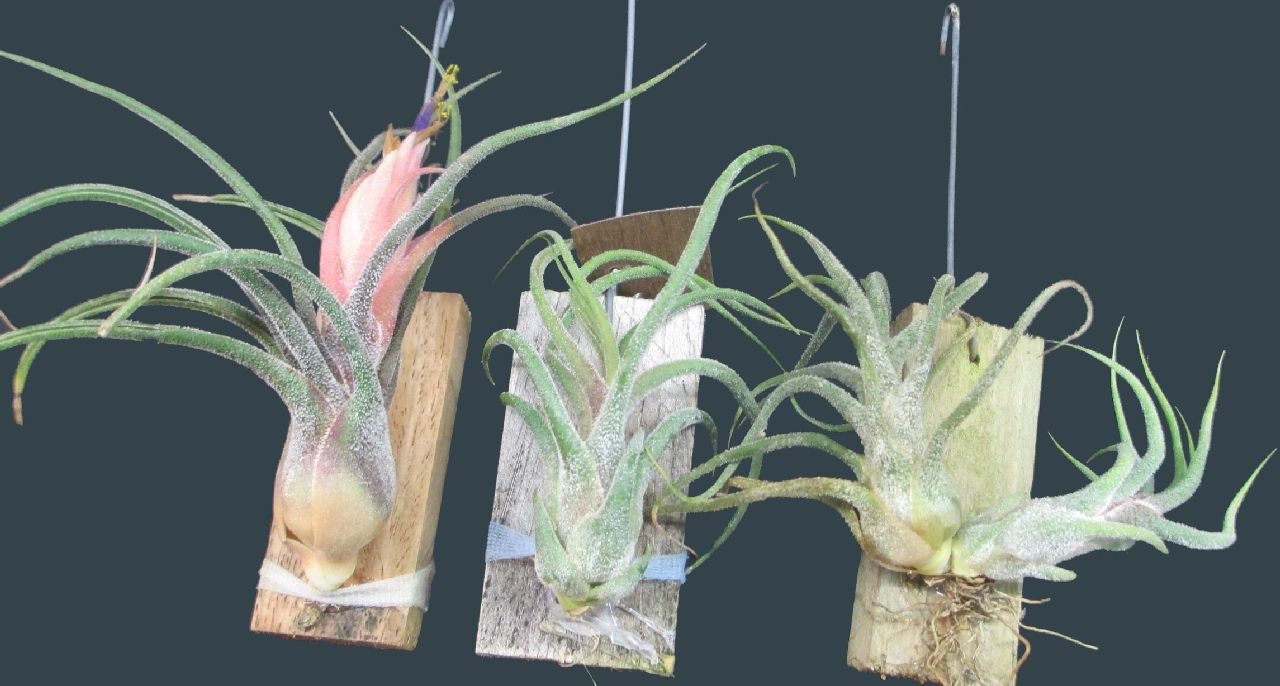
| Rob Bower 01/20 "standard/small pruinosa" |
Bob Hudson 01/20 |
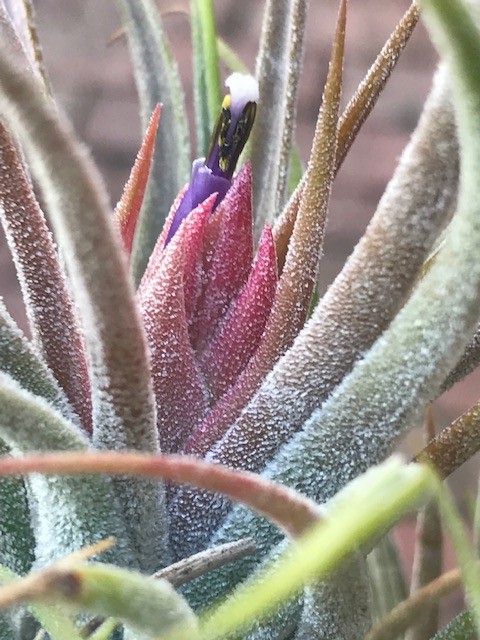


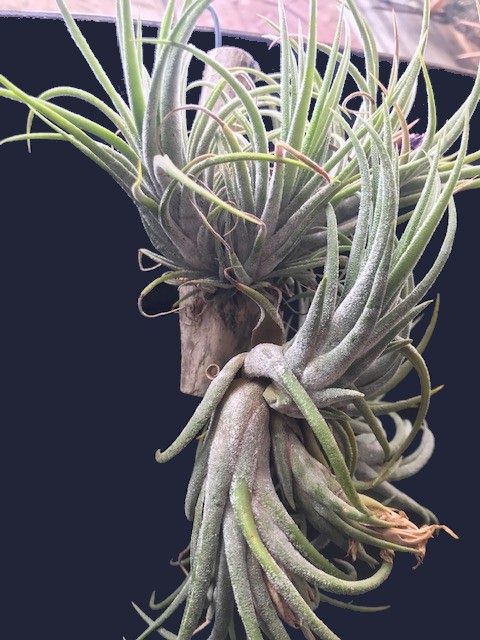
| Geoff Beech 01/20 as "pruinosa califani" |
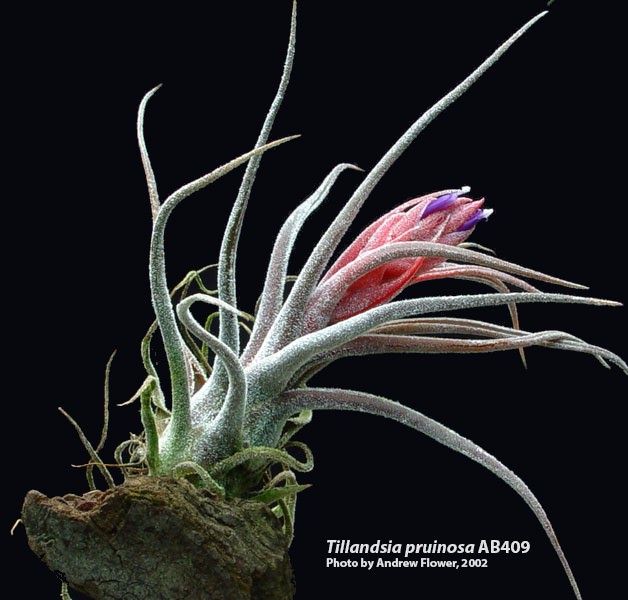

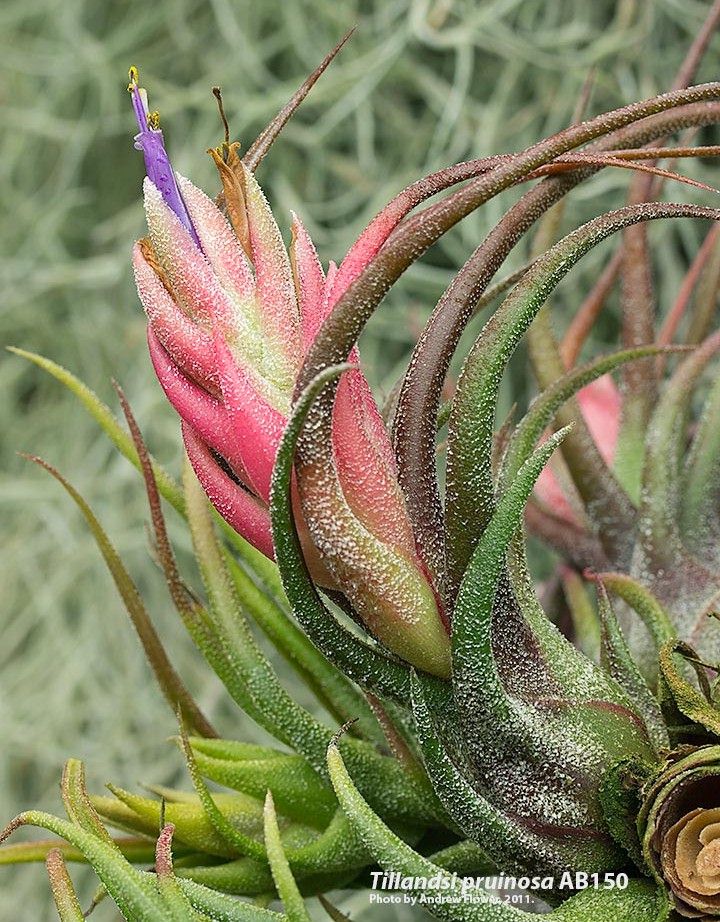
| Andrew Flower 01/20 "T. pruinosa Dominican Republic. Import 1995 from Birdrock Tropicals- T152." |
Andrew Flower 01/20 "different form, also from a US nursery 1990's - probably Tillandsia International or Tropiflora." |
Updated 13/06/20


















